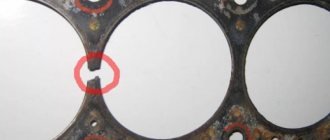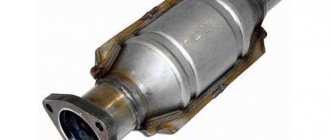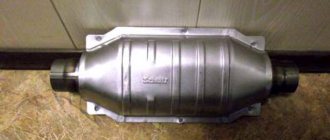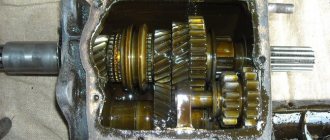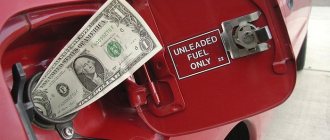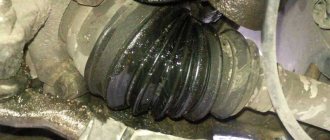The catalyst, like any other car system, will sooner or later fail. There is an opinion among drivers that he:
- not at all adapted to the low quality of domestic gasoline and noticeably reduces engine power;
- It clogs quickly and increases gas mileage, so it is better to remove it.
What should I do – remove it or periodically check its functionality? Refusal of the catalyst, of course, will eliminate the problems of checking and replacing it. But it is designed to remove components harmful to human health from exhaust gases as much as possible.
If you remove the catalyst, the electronic control unit will treat this as a breakdown in the exhaust system and will generate an error accordingly. This problem can only be solved by flashing the electronic control unit.
Signs of a clogged catalyst
One of the main symptoms of a malfunction is a decrease in engine power and a noticeable deterioration in vehicle dynamics. This is manifested by a noticeable decrease in maximum speed and sluggish acceleration when starting from a stop at a traffic light or when overtaking. There are other signs indicating problems with the catalyst:
- Difficulty starting both cold and hot engines.
- If the unit is severely clogged, a complete failure of the power unit is possible.
- An unpleasant smell of hydrogen sulfide (rotten egg) appears in the exhaust.
- Engine speed spontaneously decreases or increases.
A malfunction of the catalyst may be accompanied by the Check Engine light on the instrument panel.
The control lamp turns on when the active substance is suddenly destroyed or the wires transmitting the signal from one of the two sensors are damaged. They are installed in front of the inlet and after the outlet pipe of the unit and control the content of active oxygen. With gradual clogging, the indicator does not indicate system failure.
Rice. 2 – “Contamination and destruction of the catalyst filler”
Why does the catalyst clog?
There are many reasons for this. As you and I know, this is a kind of filter that should clean exhaust gases, making them less toxic. Usually these are small ceramic honeycombs (on which a thin layer of noble metals, usually the platinum group, is applied), assembled into a special block, which are located in a special thickening of the muffler. When gases pass through, this “block” heats up to approximately 750 - 900 degrees and, under the influence of temperature, bad gas compounds are converted into safe ones.
The honeycombs are very thin (about 1 square millimeter) and they can really become clogged, this is due to systematic disruption of the engine:
- Contact with antifreeze or antifreeze . If you have a broken head gasket, or there are heat exchanger leaks, and the block itself may be damaged (in general, the coolant runs out ). Often it enters the engine cylinders and then settles with the exhaust gases on the surface of the catalyst. Not only clogging occurs, but also melting of the surface.
- Oil getting into the exhaust . This is when the power unit has an “oil leak” (the oil level is constantly falling), and the owner does nothing for a long time. Oil settling in the honeycombs does not burn, but gradually clogs them.
- Bad fuel . If you fill in some counterfeit gasoline , then during the exhaust stroke it may not yet burn out, but the burning one goes into the muffler and melts the surface of the catalyst.
- Bad firmware . If you upload untested firmware (do chip tuning ), you may again get the effect of unburned fuel, because the ignition system may be damaged or set incorrectly.
- Gas engine fuel . Or simply gas, it has its own control unit, if you configure it incorrectly, again the burning mixture will escape into the muffler and catalyst. And the exhaust from gas is much hotter than from gasoline.
Causes of a clogged catalyst
The full name of the mentioned unit is a catalytic exhaust gas converter, which is a complex structure. The stainless steel housing contains a ceramic or metal carrier with many longitudinal pores of small diameter called honeycombs. It is installed directly behind the exhaust manifold in front of the cutter, muffler and exhaust pipe.
With long periods of operation, carbon deposits form in the pores or they become clogged with solid particles, the reasons for this are:
- Long-term use of low-quality gasoline or diesel fuel, which does not completely burn in the cylinders and forms a large amount of soot. Afterburning of fuel vapor occurs inside the carrier, which leads to its overheating and deformation.
- The use of leaded gasoline is especially unacceptable; tetraethyl lead will damage the catalyst in a short time.
- Large oil waste due to wear of the piston oil rings or valve stem seals.
- Mechanical destruction of the filler is a consequence of impacts on the unit body due to road unevenness.
Rice. 3 – “The principle of operation of the exhaust gas converter”
With rare exceptions, clogging of this device occurs as a result of prolonged use of a faulty motor. Therefore, when the first signs appear, it is necessary to check whether the catalyst is clogged or not using one of the methods suggested below. In the early stages, it is easier to eliminate engine defects and restore the functioning of the unit.
The catalyst does not work: reasons
The reasons for incorrect operation and complete inoperability are simple and understandable - the catalyst cells are either clogged with dirt or it is deformed:
- low quality gasoline. Unfortunately, at our gas stations, drivers are often offered, at best, a cocktail consisting of high-quality fuel and low-octane gasoline with additives that increase the octane number. The result is that the fuel does not burn completely, and its remains burn out in the catalyst, filling it with soot and other products. Over time, it becomes clogged and prevents the free passage of exhaust gases;
- cells are too small. Most likely, the reason is that this is a non-original device of inadequate quality. This often happens when using the original intended for US users, where gasoline of excellent quality does not clog even small cells with combustion products;
- engine malfunction. There are a great many causes of malfunction, which may result in increased consumption and loss of power. Only self-diagnosis or at a service station will help you understand them. What does the catalyst have to do with it? It is simply a symptom of the fact that not everything is in order in the internal combustion engine systems;
- Driving over rough terrain, aggressive off-road driving style, careless overcoming of barriers will sooner or later lead to deformation of the exhaust system devices located on the bottom of the car.
Let's summarize a preliminary result - the driver should take full responsibility for the quality of gasoline, behavior on the road and the selection of failed spare parts and components. Otherwise, it will take a lot of money to fix the problem.
How to check if the catalyst is clogged?
Diagnostics of the exhaust system can be carried out by the driver himself or by car service specialists. The most reliable way to both check the catalyst and eliminate its malfunction is to dismantle and inspect the unit. However, this method is the most complex and time-consuming: the fastening bolts stick, and the threaded connections cannot always be unscrewed.
Rice. 4 – “Visual check of the catalyst”
If, during the inspection process, powder spills out of the catalyst removed from the car, this indicates its destruction. This unit definitely needs to be replaced. If things have not gone to extremes, you can verify that the honeycomb is clogged by shining a flashlight into one of the nozzles. If you do not see light on the other side, then most of the pores are impenetrable to the light beam and exhaust gases.
Rice. 5 – “Checking the catalyst with a pressure gauge”
There are other less labor-intensive methods for checking the catalytic converter, which are used by service stations and drivers:
- We try to close the exhaust pipe with a gloved hand while the engine should be running at idle speed. If the exhaust system is working properly, this will not be possible; you will clearly feel shocks in your hand.
- Measure the pressure in the exhaust manifold using a pressure gauge connected to the fitting instead of the residual oxygen sensor (lambda probe) at the inlet of the catalyst. If this indicator exceeds 0.3 kgf/cm2 at an engine speed of 2500 min-1, then the unit is faulty.
- You can accurately determine a clogged catalyst using a motor tester. In place of one of the spark plugs, a special pressure sensor is installed, the readings of which are displayed on an oscilloscope. The specialist can only evaluate the operation of the engine at high speeds. Pressure in the exhaust system of more than 2 kgf/cm2 directly indicates that the filler is obstructed.
The choice of method for checking the catalytic converter is at the discretion of the car owner. It should be noted that the most reliable methods are dismantling and visual inspection of the unit and diagnostics using a motor tester.
Rice. 6 – “Checking the catalyst with an oscilloscope of a motor tester”
Purpose of the catalyst
The main purpose of the catalyst on modern cars is to reduce exhaust toxicity, which allows the car to fit into strict European standards for environmental friendliness of the car. The honeycomb structure of such a filter removes harmful impurities and heavy metals from exhaust gases. Catalysts are made from special rare-earth alloys, which explains its high cost.
Over time, the efficiency of the catalyst drops significantly, the metal honeycombs begin to burn out and become clogged with soot, after which it is necessary to replace the filter or remove it. Taking into account the high cost of catalysts, most car owners decide not to change them, but simply cut out and install special decoys. However, such a solution has certain pitfalls, including a significant increase in environmental damage and the appearance of an “oil burner” in the engine.
Is it possible to drive with a clogged catalyst?
The consequences of operating a car with a seriously defective exhaust system can be quite severe. It must be recalled that when the catalyst fails, the following is observed:
- Increased content of harmful substances in exhaust gases.
- There is a significant drop in engine power.
- Due to an increase in exhaust tract resistance, fuel consumption increases significantly, which entails an increase in operating costs.
- When using a car for a long time with a clogged catalyst, at some point the engine simply will not start or, worse, stall while driving.
The greatest damage is caused to the engine in the event of destruction of the catalyst filler. The resulting solid particles can get into the cylinder between its inner surface and the moving part - the piston. As a result, scratches form on the mirror, which can only be eliminated during a major overhaul by grinding followed by honing.
Why do you need a catalytic converter in a car?
Most of the exhaust gases consist of completely neutral and harmless substances - nitrogen, water vapor and carbon dioxide. But it is almost impossible to get by with their presence alone; this only happens in a perfectly tuned engine operating in a predictable stationary mode.
In all other cases, the engine begins to emit chemically active substances that are extremely dangerous to humans, carbon monoxide, hydrocarbons and nitrogen oxides.
Direct destruction of such poisons at high speed and in the required volume is practically impossible, so engineers were forced to resort to catalytic reactions known from chemistry for processing harmful substances into relatively neutral ones.
In chemistry, a catalyst is a reaction component that participates in a process, accelerates it well, but is not consumed.
What is valuable in the device
Unfortunately, there was a lot of valuable stuff there. Noble metals, most suitable for this purpose, had to be used as catalysts.
It got to the point that the cheapest of them turned out to be gold, but more often it is necessary to use platinum, palladium and rhodium. Many people know that these elements are significantly more expensive than gold, which everyone understands.
Simultaneously with the use of such expensive components, it was necessary to create a geometrically complex structure that would ensure contact of the catalytic substance with the entire volume of gas released by the cylinders. These are the smallest ceramic or metal honeycombs through which the entire exhaust flow is blown.
As a result, the car acquired a complex, massive and expensive device in the form of a metal case, high-tech filling, and even framed with control sensors on both sides, continuously monitoring its safety and proper operation.
Eco-friendliness does not come for free. And progress did not stop there; further tightening of legislative requirements continues to influence the emergence of additional exhaust cleaning systems.
What to do if the catalyst is clogged?
As is clear from the above, ignoring a malfunction is fraught with big troubles. A reasonable question arises, what to do if the catalyst is clogged and this has been established absolutely accurately. There are several possible ways out of this situation:
- Try to clean the filler from carbon deposits and solid particles. There are different methods, the description of which is beyond the scope of this article. Another question is that their effectiveness is highly questionable. They are applicable only at the very initial stage of the process, when there are still no signs of clogging of the unit, and no one thinks about a possible malfunction.
- Removing filler from the body and installing a flame arrester and emulators instead of residual oxygen sensors. In this case, you will always forget about the malfunction of the catalyst, but this interference in the design of the exhaust system is easily detected using a gas analyzer, and you will face a fine for environmental pollution.
- Replacing the catalytic converter with a new one. This is the most expensive option - purchasing and installing the unit will cost from 9 to 17 thousand rubles, depending on the make of the car.
There are so-called sports catalysts, which, according to reviews from experts and car owners, provide a power increase of up to 10%. The active elements used as filler make it easy to meet the stringent requirements of current Euro-4 and even Euro-5 standards.
Rice. 7 – “Replacing the catalytic converter on a car”
What to do if the catalyst fails
There are only three options:
- Replace with original
- Replace with universal
- Install a flame arrester
There are no questions with the first point, and it is the most reliable. An original spare part or its official substitute is the best solution to the problem, although it is the most expensive.
By installing a universal catalyst, no one can guarantee a long service life, as well as the fact that the engine will accept it as its own, but on the other hand, you will not cause unnecessary harm to our air, which we breathe. You may need an additional engine chip service to rid it of the sensor that monitors the efficiency of the catalyst (second lambda probe) and gives the engine a command to reduce fuel if something goes wrong.
The third point is perhaps the most popular. The flame arrester will reduce the exhaust temperature, just like the catalyst, eliminating new noise. But when installing a flame arrester, it is imperative to deactivate the second lambda probe using the engine chip. Well, a huge disadvantage of this method is that it reduces the environmental friendliness of your car.
